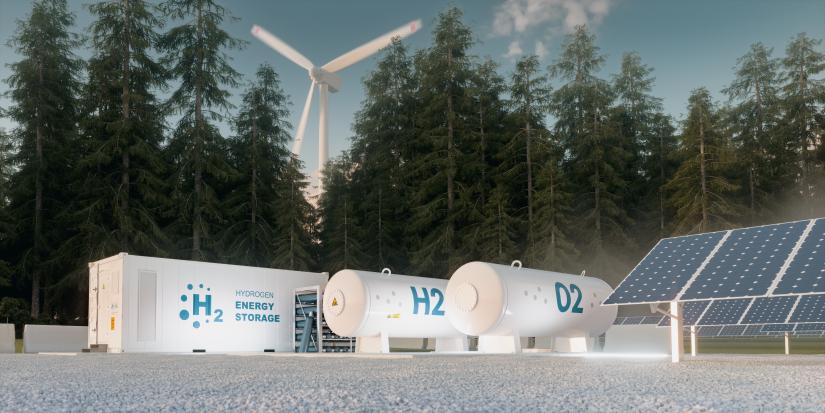Hydrogen could hold the answer to the world’s energy needs. It can generate heat for heavy industry, power electric vehicles, and be used as feedstock for chemical manufacturing. In 2021, governments globally pledged more than US$70 billion to support the hydrogen industry.
But because hydrogen is a gas, it is difficult to transport and store. The development of a global hydrogen economy has been stymied by a lack of infrastructure and technology to transport and store large amounts of hydrogen.
Conventional methods that compress and liquefy hydrogen can increase its density, but they require large amounts of external energy to achieve high pressure (for compression) and extremely low temperature (for liquefaction), reducing the overall net energy.
Using boron to store hydrogen power
A team of 20 top cross-disciplinary experts led by Professor Zhenguo Huang of the Faculty of Engineering and IT are studying a range of new compounds known as hydrogen carriers.
These compounds are hydrogen-rich and hold hydrogen either physically or chemically, then release it under certain conditions such as by changing temperatures and pressures or using catalysts.
Professor Huang says the compounds hold potential for hydrogen use at large scale, such as for powering heavyweight trucks over long distances or to ship energy from Australia to countries with low renewable energy capacity.
“These compounds could help Australia build an export market to meet the hydrogen demands of some of its key existing trading partners such as Japan and Korea, who have implemented policy commitments for hydrogen use but lack sufficient supplies,” he says.
“This work has the potential to create new jobs and make a significant impact on renewable energy, chemical, and manufacturing industries.”
Professor Huang initially pioneered the use of boron-containing compounds to store hydrogen. His team and collaborators developed low-cost synthesis of sodium borohydride (NaBH4), which overcome the high cost and energy requirements of using this compound to store hydrogen.
He has teamed up with a leading Australian chemical manufacturer, Boron Molecular, in manufacturing hydrogen-rich compounds as hydrogen carriers.
Alternatives to liquid natural gas
Professor Huang’s leading research has attracted industry sponsorship including from the world’s largest liquid natural gas (LNG) importer, the Korea Gas Corporation (KOGAS).
In a recent discovery funded by KOGAS, Professor Huang and his team have developed a liquid system that can release hydrogen at room temperature, meaning hydrogen can be handled with better safety and enhanced energy efficiency.
This new hydrogen carrier will enable hydrogen to be transported by the existing LNG infrastructure, such as tankers and pipelines. KOGAS has recently filed a patent, with a view to using the types of compounds to transport hydrogen from Australia to South Korea.
“Instead of importing huge amounts of LNG, companies like KOGAS we hope will be able to use our technology to import hydrogen,” says Professor Huang.
“They are shifting to hydrogen with a view to generating a similar amount of energy and generating a similar amount of revenue in the near future. Our technology has huge potential to play a key role in their business.”
The company recently announced plans to supply 830,000 tons of hydrogen per year by 2030 to South Korea, including importing green hydrogen from overseas from countries such as Australia.
New partnership to expand scale
Professor Huang’s team has built a new partnership worth more than $4.7 million to scale up the processes to produce sodium borohydride.
The partnership with Boron Molecular and commercialisation firm GrapheneX received Cooperative Research Centre Project funding to develop a pilot plant demonstrating the feasibility of industry-scale sodium borohydride production.
The work was also recently garnered an additional $460,000 in Australian Research Council Discovery Project funding to develop the new technologies.
Find out more about the work of the Hydrogen Energy Program
Research team
-
Faculty of Engineering and IT
-
Faculty of Engineering and IT
-
Faculty of Engineering and IT
-
Institute for Sustainable Futures
-
Faculty of Engineering and IT
-
Australia-China Relations Institute
-
UTS Data Science Institute
-
University of Wollongong










